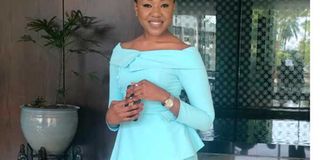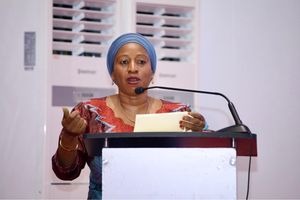It’s a waste free period for Flora

Flora Njelekela, founder of Hedhi Cup
Before 2015, 31-year-old Flora Njelekela had no idea what a menstrual cup was.
Menstrual cup, made of medial silicone, is a bell-shaped cup that collects menstrual blood. This flexible cup snugly fit into a woman’s vagina, catches the blood while she is on her periods. Once full, the cup can be emptied into a sink or toilet, washed and reinserted.
Just like many Tanzanian women today, when Flora heard about it for the first time, she too thought it was a strange concept. But an incident back at her grandmother’s village in Songea changed everything for Flora.
The idea of ditching the sanitary pads to an eco-friendly menstrual cup and also introducing it in Tanzania was borne out of what Flora says, “An eye-opener”. Flora hadn’t seen her grandmother for quite a while and decided to pay her a visit in the southern highlands.
One fine day, she took notice of an old, rag cloth that was hung on the rope. She asked her grandmother as to what these scraps of cloth were. “This is your cousin’s menstrual cloth which she uses when on her periods,” the grandmother responded. Flora was taken aback. The cloth did not seem hygienic at all, because her cousin would wash, dry on a rope and would re-use it again without ironing.
Flora’s cousin isn’t the only one. For many Tanzanian women and girls today, sanitary pad is a luxury and that is why most resort to unhygienic practices such as rag cloths, while some use soil and ash to soak up period blood. “I decided to give her my packet of sanitary pads.
But then I thought, what will happen to my cousin after I leave. Next month she will resort to the same dirty cloth because my grandmother cannot afford to buy her sanitary pads every month,” Flora tells in an interview with Your Health.
Flora came back to Dar es Salaam with a burden of thoughts of how to change her cousin’s life, and many other girls alike in the village.
She began her research on a sustainable, safe solution. She wasn’t far off with her research when one day she stumbled upon her colleague who was using a menstrual cup. “I found it strange but at the same time I wanted to know more about it, how it works, its durability and how hygienic it is.
So I started researching on it,” Flora adds. I was my own guinea pig Flora discovered that the menstrual cup can be used for more than five years. “I was my own guinea pig. I began wearing it in 2017 to see how comfortable, safe and hygienic it is. It’s something I cherish now,” Flora shares her own personal experience.
She adds that she can do anything with it without worrying about any leakages, discomfort or bad smell. “But upon my research, I found out that the menstrual cups were available in many countries but were not available in Tanzania,” Flora tells.
That’s when she decided to introduce menstrual cup under her brand name Hedhi Cup, that is sold for Sh30,000, making her the first Tanzanian woman to introduce this eco-friendly alternative. “I sort of finally felt safe for my cousin.
The soft, flexible cup made out of 100 per cent silicon, collects fluid three times more than normal pads making it a better substitution for unhygienic methods such as rags,” Flora tells. That means, for a normal period flow menstrual cups can stay in for up to 12 hours before being emptied and rinsed.
How safe is it? Dr Anna Mahecha, a gynaecologist based at Sanitas hospital in Dar es Salaam tells Your Health that a menstrual cup can be used by every woman; the difference is only the size. This can be measured by age and the amount of period flow.
She adds that she personally hasn’t used one because she wasn’t aware of its availability in Tanzania. “The menstrual cup is environmentally friendly. One cup can be used for more than five years without disposing it.
While with the normal sanitary pads, there is a lot of disposal and waste, some of them do not dissolve,” says Dr Mahecha. Besides its economic and environment factor, the cup is less prone to allergies or infection. “The material, silicone, that is used to make the cup make is safe as long as they are properly cleaned and preserved. You see with the cup, they collect instead of absorbing the fluid, making the user clean and dry,” she tells.
Upon asking about safety for girls who aren’t sexually active, Dr Mahecha says, “It is safe for virgins to use them.
They may feel a little uncomfortable at first but if inserted properly, it has nothing to do with virginity as it is not as deeply inserted as a tampon would. In fact they are better to use if one has a big period flow and prone to leakages.” The only impediment when it comes to wearing a cup requires proper knowledge on how to use, clean and preserve.
Are Tanzanian women willing to switch to a cup? Majority of women that Your Health interviewed were skeptical to try or switch to a menstrual cup.
Their responses varied from, “it looks uncomfortable”, “it might be a good thing to save the environment, but personally I won’t use”, to some saying “it is expensive.” The brief survey showed that like periods, there are several myths and apprehensions associated with menstrual cups. But out of those interviewed, Iman Hatibu, a communications officer with a policy forum in Tanzania, was the only one from the lot who touted the cup to be the most sustainable method of managing her menstruation. “I started using menstrual cup in 2015 before it was introduced in Tanzania.
I had ordered it from Finland. It had turned out very expensive. The cup is very comfortable and I can literally do anything with it – eat, sleep, swim, and more without feeling any sort of discomfort or leakage,” Iman, the mother of one, tells Your Health. Iman is very sensitive when it comes to allergies or infection.
“I have never experienced any sort of infection, in fact I don’t remember the last time I had a urinary or fungal infection,” she says. Adding on the skepticism from women, Flora says, “I can totally understand why women would have a negative approach towards this alternative. I was in their shoes.
That is why as a Hedhi Cup founder, I am emphasising first on educating women on its use and why it is a better, safe choice for women.” At an event held last week, Tanzanite Women Forum, Flora was one of the key speakers on menstrual hygiene and empowerment. She said at the forum itself, the kind of questions that were shot at her by women of different age and ethnicity had a skeptical tone.
But after educating the women about the cup, more than 40 women changed their minds and decided to try the menstrual cup.
The question of affordability For middle-income earners, the menstrual cup might seem an economical choice but for those who come from a less-fortunate background, the cup is still a luxury item.
In order to reach out to the masses, Flora says, “Yes it still seems a lot of money for those who come from a poorer background.
We have been sending proposals to corporates, NGOs and companies to buy these so that we can go the villages and educate them on its use. This is just a start, more needs to be done.”




